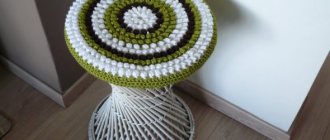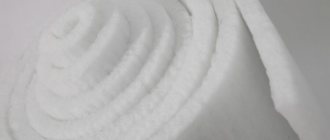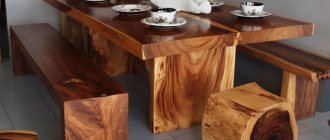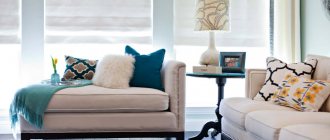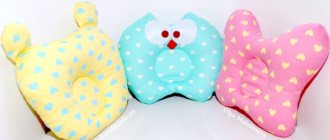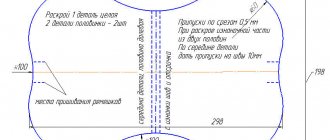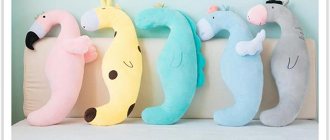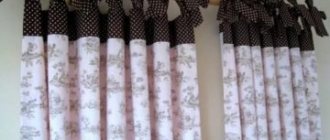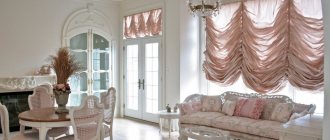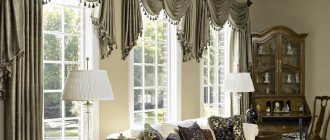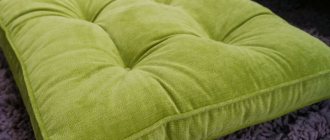Garden furniture is used in difficult conditions, so it is made durable, reliable and easy to use. As a rule, such furniture is equipped with removable soft pillows, which, if necessary, can be brought into the house during rain or winter, washed or dry cleaned. We tell you what to look for when choosing pillows for furniture for your dacha, so that they last a long time and provide you with maximum comfort. We’ll also look at how to make cushions for garden furniture with your own hands.
How to sew a soft cushion on a chair with your own hands
Even before you start sewing a seat, you need to decide on the color (according to furniture, curtains, wallpaper, etc.), the type of product and how to attach it to the chair. Here everything will depend on the characteristics of the environment and the preferences of the person concerned.
In order to prevent health from deteriorating, we came up with chair cushions that are designed to solve this problem.
Important! When the purpose of a thing is convenience, it is better to choose calm, neutral colors. And if you want to add some zest to the design of the room, you should give preference to bright fabric with an unusual pattern. The color of the sewing threads should be in harmony with the material from which the pillow is sewn.
Since no one wants to encounter such a phenomenon as the seat sliding off the high chair, you should think about a suitable method of securing it:
- ties;
- ribbons;
- Velcro;
- rubber bands.
With the help of textile components, you can transform any room interior beyond recognition.
In addition, suitable materials and tools are prepared in advance. And it’s good if you work on the pattern in advance in accordance with the desired size and shape. But step-by-step instructions will tell you how to sew a pillow on a chair with your own hands, allowing even a beginner to complete the job. In order not to be mistaken, it is worth dwelling on each of these questions separately.
Selection of tools and materials
The seat cushion will serve for a long time and will fit harmoniously into the environment only with the right choice of materials and careful adherence to the instructions for performing the work. The necessary tools will help ease the effort and improve the quality of performance. To sew a seat, you will need the following:
- Sewing machine;
- Awl;
- Scissors (preferably tailor's);
- Threads of different thicknesses and needles of different lengths.
Before starting work, stock up on the necessary tools and materials.
Textile
In addition to color, when choosing fabric for a pad, you should pay attention to wear resistance and guaranteed durability. In this regard, it is worth highlighting rep, teak or satin. And in the case when the chair will be used outdoors, it is best to give preference to felt fabric or use old jeans.
With the choice of suitable material, the strength characteristics will match the nature of use. In addition, an attractive appearance and the most comfortable feeling for a person are achieved. The most important thing is that it is easy to avoid unnecessary expenses. The fact is that for such work they usually take materials and tools that can be found in every home.
If the pillow is intended to be used as a seat, then you need to pay attention to durable, wear-resistant fabrics such as gabardine, rep or teak.
Filler
One cannot but agree that each of us wants to sew a seat on a stool in accordance with our own ideas about comfort. A special role here is played by the characteristics of elasticity and resistance to deformation. The correct choice of filler will help you achieve the desired results. When it comes to bench seats, a variety of materials are used:
- Hollow fiber (good shape retention);
- Sintepon;
- Synthetic fluff;
- Foam rubber (thin furniture version);
- Latex;
- Buckwheat and sunflower husks;
- Small scraps of yarn and non-woven fabric;
- Bulk polystyrene filler, etc.
If the choice falls on synthetic fillers, the most commonly used ones are polyurethane foam, polystyrene, synthetic padding, and holofiber.
Another requirement will be the environmental safety of the material. In addition, you should remember the following points:
- If one of the fillers is unstable, use 2-3 layers;
- For foam rubber and holofiber, the correct pattern is enough.
Pattern
To make a pattern for a chair cushion with your own hands, all you need to do is decide on the size and choose the shape of the product. In accordance with individual preferences, it can be a rectangular object, round or an intricate configuration. And although everything is determined by the size of the chair or stool, the pattern should be a couple of cm larger than the area of the seat for which it is being sewn. The fact is that as a result of stuffing, the dimensions of the product change downwards.
Before cutting, you should ensure that the pattern includes all possible tolerances.
Additional Information! Exact matching to the dimensions of the chair is ensured by using tracing paper, which is applied to the seat and outlined with a marker. And you can cut a pattern with scissors only after the desired shape of the product has been drawn in accordance with careful calculations and measurements.
Sewing a pillow
When it comes to sewing a pad, it is very important to follow the step-by-step instructions:
- Cut out the shape of interest according to the outline of the pattern markings.
- Cutting 2 identical pieces of fabric (with an allowance of 1.5 cm).
- Preparing the filler (according to the pattern).
- Stitching the piping on a sewing machine and attaching it to the fabric (above).
- Place the two pieces of the pillow next to each other, pin them together and sew them together.
There is only a small pocket left to insert through the filler. Next, you should turn the existing allowances, undercuts and corners inside. The already sewn cover needs to be carefully ironed and filled with filler. And the edges of the hole through which holofiber, foam rubber or padding polyester gets into the pillow should be aligned, bent inward and stitched with a hidden seam. At the same stage, all seams of the quilted pillow are stitched.
In some cases, the filler is additionally stitched to avoid the formation of lumps and matting.
Important! Don’t forget to mark in advance the attachment points for the ties that will be sewn on the underside of the workpiece.
In the case of sewing using the patchwork technique, the pattern is prepared using different patches (often different not only in color, but also in shape).
In addition to its useful purpose, the product will also play the role of decorative decoration.
Note! The greater the differences between the parts, the more interesting the product will be.
Tips for choosing the right finished copy
In the manufacture of the main structure of the swing, various materials are used - from plastic (lightweight) to metal, more stable. Plastic swing supports are lightweight and inexpensive, and are designed for children. They present no difficulties during transportation and assembly.
Choose the softest material for greater relaxation pleasure
The metal supports are strong and reliable even when used by adults.
When choosing a finished product, you should take into account such important criteria as:
- what kind of load is expected for this structure (children or several adults);
- how often this swing model will be used (permanently or occasionally).
In accordance with these requirements and the instructions for the model you like (the maximum load is not indicated), make your choice.
How to make a knitted round chair cushion
Each of us is free to decide whether a cushion will be sewn for the stool or, to suit our own preferences, we will have to make a knitted version. In the second case, a soft item for interior decoration and increased comfort is knitted from yarn using a hook or knitting needles. To make a round chair cushion with your own hands, follow the circular pattern.
Such products are often made in the form of thin mats for benches, plastic or wooden chairs, or for the back of a chair.
Note! With a preference for knitting, there will be no problem creating colorful seats similar to the patchwork technique. To do this, the product is made by connecting multi-colored rhombuses, squares, etc. together.
It will not be difficult to prepare soft knitted items from pompoms. For their manufacture, the remains of any colored yarn, previously wound on a template or fingers, are suitable. To get a fluffy ball, the base must be tied in one place, cut and fluffed. Well, then the pompoms are tied at the same distance onto a mesh base made of plastic, curtain fabric or crocheted mesh. In addition, knitted pillows can be decorated with tassels in the corners.
Additional Information! Seats for stools turn out to be especially beautiful if they are knitted from fancy yarn, similar in appearance to “fur” or “grass”. Moreover, you choose the knitting density and pattern yourself.
Shape and design
As a rule, square or rectangular pillows
to suit the size of the seat or backrest. The most popular sizes of square garden pillows are from 35 to 50 cm, rectangular - 60x30 cm, 62x42 cm and 62x37 cm. The best thickness for lumbar pillows is 5-8 cm, and for sitting sofas, benches and armchairs - 6-12 cm. In addition, round pillows are sewn for stools, poufs and banquettes, and trapezoidal patterns are made for chairs and garden furniture of non-standard shape.
Decorative pillows for country furniture
can be of any shape, size and thickness. However, when sewing them, also use all the rules for garden pillows. Choose dense and durable, well-dyed fabric and durable synthetic filling. Despite the fact that you will not sit on such pillows, they will still be subject to the same harsh environmental influences.
Decorating a pillow
A ready-made pillow of any type can be easily transformed by decoration. Products decorated with beads, beads, sequins, buttons, etc. are suitable for interior decoration. Well, if your goal is to increase comfort, then the best options would be not too voluminous appliques, ruffles, lace or embroidery.
To avoid problems with the drawing, first make a sketch, transfer it to tracing paper and cut out a stencil. And if braid is used as decoration, it is first pinned with pins, and only then sewn on by hand.
Almost any decorations are suitable for decorative models: bows, embroidery, appliqué and others.
Open the cover
Instead of taking a lot of measurements, I decided to keep it simple. I placed the fabric with the wrong side on the table, foam rubber on it, wrapped it so that it did not tighten it too much, and secured it with pins. This is suitable for the option when you have thin foam, but thick foam requires a different cut. Now you can see how much fabric can be trimmed. Then I drew lines along the measurement to cut straight, left 1 cm at the seams, and cut the fabric.
Pillow care
All items that come into contact with people in one way or another need sanitary and hygienic procedures. Seats for benches will be no exception. It is noteworthy that proper care of them prolongs their operation, maintaining an attractive appearance and shape. The appropriate procedures depend entirely on the design features and type of filler.
Bright decorative pillows have a great effect not only on the mood, but also on the entire environment as a whole.
In some cases, washing is allowed (hand or gentle in a washing machine). If light and monochrome products can be placed in water with a temperature of 40 degrees, then the presence of bright and combined shades forces the use of exclusively cold water. Some items can only be dry cleaned by a professional dry cleaner.
The product must be dried in a horizontal position. This is the only way to prevent the filler from clumping. When unfolding the seat, do not allow any folds to form. The item should be turned over from time to time. As for ironing, it is not recommended.
To change the mood and dynamics of the interior of the room, just change the covers on the decorative pillows, and you will get new unforgettable impressions from the comfort and relaxation zone.
If all instructions regarding sewing, operation and care are followed, things will delight us with comfort and aesthetic appeal for a long time. Moreover, making cushions for stools and chairs does not require any special skill. It is also important that working with your own hands increases self-esteem and serves as an excellent opportunity to decorate your own home without additional costs.
Types of fillers
There are many mattress fillings. They are divided into soft, medium and hard.
Relax after work in a soft swing on your site
Among the soft fillers, we especially note natural latex. It is made from rubber plants. The material is waterproof, does not mold, does not rot, and is hypoallergenic. It is a leader among other comfortable fillers.
The most popular medium fillers:
- Polyurethane foam. In everyday life it is known as furniture foam rubber. It is characterized by wear resistance and durability. This artificial porous material is not susceptible to mold and does not pose a danger to allergy sufferers. It has different thicknesses and is easy to cut when cutting. The price is quite affordable for people of average income.
- Sintepon is a lightweight artificial filler for pillows and mattresses. Soft, light, springy fabric that has the ability to quickly recover from deformation, does not absorb moisture, and is non-toxic. Small items can be washed even without removing the covers.
- Polystyrene is another representative of the new generation of artificial materials. They are small, light granules. Environmentally friendly filler, does not absorb odors, does not allow water to pass through. Harmful microorganisms do not grow inside polystyrene, the material does not burn or ignite.
Fans of hard fillers can use natural materials such as coconut (coir) or seaweed.
Helpful hints
Any product requires proper care. Simple rules will help extend the life of your garden swing:
- when it rains, take soft upholstery indoors;
- If wet, dry the covers in the sun;
- For minor stains, simply wipe the fabric with a damp sponge;
- after the end of the season, wash the covers in the machine in the appropriate washing mode and fold them until the next use;
- purchase protective covers from the rain; in extreme cases, always have a large piece of polyethylene and twine on hand.
We hope our tips will be useful to you when relaxing in the country.
Hallway seat: 10 options
Author: Alexey Alekseev
The seat is not an absolute, but clearly not an extra element of the hallway. The chance to sit down significantly increases the comfort and functionality of the room. Putting on shoes, getting your baby ready for kindergarten, or waiting for your wife to prompt you for a marathon is undoubtedly more comfortable while sitting. And an unexpected guest who comes in for a short time must also be given the opportunity to sit down.
As a result, if the size allows it, the hallway should definitely be equipped with a seat. In addition, for small rooms there are very compact models that allow you to combine in one product both an element for sitting and space for storing shoes and other things.
In our article we will describe several seating options for the hallway.
Hallway seat
Built-in seat
If there is an alcove in your hallway, it is quite possible to equip it with a seat. You can make it a stationary product made of chipboard, or order its production according to your drawings in the workshop. This solution looks as graceful and elegant as possible due to the precise fit of the elements.
Let's do some handicrafts
You can make a base for a mattress for a sofa in the hallway with your own hands from wooden pallets, which can be found in any store, bring already used ones from your dacha, or buy them at a construction hypermarket. In terms of money, they will not cost much.
We recommend reading the article about Dormeo blankets.
Pallets need to be cleaned of dirt and dust, treated with sandpaper, and painted with eco-paint or varnish. These measures will help prevent burrs and scratches and prepare the structure for assembly. The base for the mattress can be made of any material, with a folding top and niches inside for storing children's toys, things, and food.
